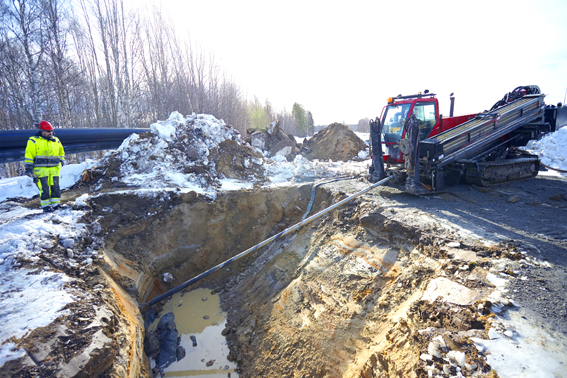New installation methods, faster pipelaying and maximum service life demand the best pipe design

The development of pressure pipes has gone from the HDPE (high density polyethylene) pipes of the 1950s via PE63 and PE80 to today’s PE100 and PE100 RC. The increasing classification of materials meets the market’s demand for increased transport efficiency, which requires pipes that can operate under ever higher pressures.
At the same time, new pipelaying techniques are being requested that are more cost effective than traditional open trench excavation. This has resulted in alternative installation methods such as pipe splitting, directional drilling and relining. These pipelaying methods, which pull the pipe through the ground, place high stress on the pipe systems with increased risk of scratches and pressure damage to the pipe walls. The increased demands for more efficient pipelaying have also led to an increased use of existing soils as backfill material. This process also increases the risk of the pipes being damaged by sharp stones that push against the pipeline. Studies and tests conducted by RISE have shown that the impact of a potential scratch or damage on a pipe cannot be assessed solely by its depth and sharpness.
“In order to assess the impact of the scratch on the performance of the pipe, account must also be taken of the material from which the pipe is made and the safety factor by which it has been dimensioned. Extensive pressure testing shows that pipes made of modern materials can withstand scratches in the pipe surface much better than pipes made of older materials.” (Acceptance criteria for scratches and indentations in plastic pipes, RISE)
Alternative installation methods
New alternative installation methods and maximum service life requirements require pipes made from the best possible raw material. At Extena we therefore recommend that you always choose pipe systems made of PE100 RC, where RC stands for Resistance to Cracks.
Extena’s PE100 RC material, certified according to PAS 1075, has 17 times higher requirements for resistance to slow crack growth (SCG) compared to the materials that the Swedish AMA (General material and work descriptions) bases its recommendations on.
By choosing PE100 RC, you will not only have pipe systems with maximum service life, but also faster and more cost effective pipelaying. This is due to significantly improved installation, since PE100 RC permits the use of backfill material with a higher fraction. And by adding a high strength protective sheath to the pipe, you will create the best conditions for a pipeline to achieve the longest possible service life.
All Extena’s sheathed pipes meet the requirements of PAS 1075 Type 3, i.e. the highest grade (pipes with a higher strength sheath).
At the same time, new pipelaying techniques are being requested that are more cost effective than traditional open trench excavation. This has resulted in alternative installation methods such as pipe splitting, directional drilling and relining. These pipelaying methods, which pull the pipe through the ground, place high stress on the pipe systems with increased risk of scratches and pressure damage to the pipe walls. The increased demands for more efficient pipelaying have also led to an increased use of existing soils as backfill material. This process also increases the risk of the pipes being damaged by sharp stones that push against the pipeline. Studies and tests conducted by RISE have shown that the impact of a potential scratch or damage on a pipe cannot be assessed solely by its depth and sharpness.
“In order to assess the impact of the scratch on the performance of the pipe, account must also be taken of the material from which the pipe is made and the safety factor by which it has been dimensioned. Extensive pressure testing shows that pipes made of modern materials can withstand scratches in the pipe surface much better than pipes made of older materials.” (Acceptance criteria for scratches and indentations in plastic pipes, RISE)
Alternative installation methods
New alternative installation methods and maximum service life requirements require pipes made from the best possible raw material. At Extena we therefore recommend that you always choose pipe systems made of PE100 RC, where RC stands for Resistance to Cracks.
Extena’s PE100 RC material, certified according to PAS 1075, has 17 times higher requirements for resistance to slow crack growth (SCG) compared to the materials that the Swedish AMA (General material and work descriptions) bases its recommendations on.
By choosing PE100 RC, you will not only have pipe systems with maximum service life, but also faster and more cost effective pipelaying. This is due to significantly improved installation, since PE100 RC permits the use of backfill material with a higher fraction. And by adding a high strength protective sheath to the pipe, you will create the best conditions for a pipeline to achieve the longest possible service life.
All Extena’s sheathed pipes meet the requirements of PAS 1075 Type 3, i.e. the highest grade (pipes with a higher strength sheath).





